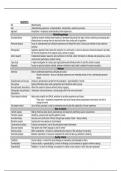Samenvatting
Summary Exam research methods: Qualitative and quantitative design table, exam theory
RM for MSc Health sciences. This document contains a summary of both research methods quantitative and qualitative and consists: methodology/design, methods, type of analysis, quality criteria, reliability and validity, sources of bias, literature reviews, meta analysis, evaluations and differe...
[Meer zien]




